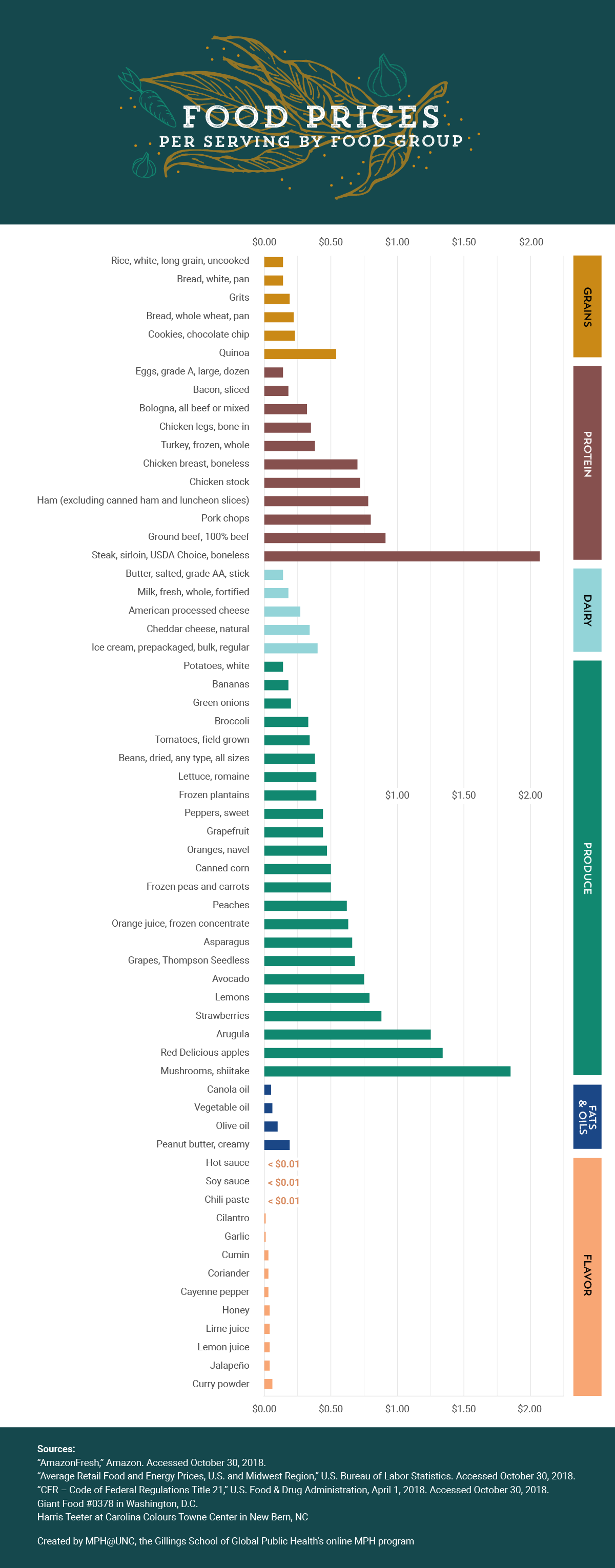How Can I Get Fresh Produce on a Budget?

More From This Guide
Many shoppers may altogether avoid the produce section of the grocery store because they think the fresh fruits and vegetables are out of their price range. It’s common to associate healthy foods with higher prices, but food price data from the U.S. Bureau of Labor Statistics suggests that many produce items, including potatoes (14 cents per serving) and grapefruit (44 cents per serving), are priced similarly to the processed foods we tend to consider inexpensive, such as ice cream (40 cents per serving) and chocolate chip cookies (23 cents per serving). Parents concerned about a large price gap between white bread (14 cents per serving) and the healthier whole-wheat version (22 cents per serving) will notice only an 8-cent difference between the two.1
Eating less meat is a good way to save money, improve the nutritional quality of your diet and protect the environment. Families trying to consume less meat will find that leaner choices such as chicken breasts (70 cents per serving) cost slightly less per serving than ground beef (91 cents per serving) and pork chops (80 cents per serving) and substantially less than sirloin steak ($2.07 per serving).2
Because of health and environmental considerations, more people are considering largely plant-based diets. An added benefit is that this way of eating is usually less expensive.

Go to tabular data at the bottom of the page about food prices per serving by food group.
Keep in mind that organic produce is generally more expensive. Also, some foods are more likely to be contaminated by pesticides than others. The Environmental Working Group (EWG) offers a helpful guide about buying organic called “EWG’s 2018 Shopper’s Guide to Pesticides in Produce™.”
Individuals and families with lower incomes can choose to apply for federally funded programs designed to help them afford a nutritionally adequate diet, such as the Supplemental Nutrition Assistance Program (SNAP) and the Special Supplemental Nutrition Program for Women, Infants, and Children (WIC).
By definition, SNAP is a supplemental nutrition benefit — not intended to make up a consumer’s entire food budget. The benefit amount a household receives depends on the family’s income and expenses.
For the purpose of this guide, we focus on SNAP. The average household with SNAP benefits receives $4.20 to spend on food, per person, per day. This means that parents planning meals must be strategic with their food choices, particularly when shopping for fresh fruits and vegetables.
Below, learn strategies for finding healthy and affordable produce where you live.
Where Can I Find Fresh Produce in My Budget?

Urban Areas
Farmers Markets
- Many farmers markets accept SNAP and WIC benefits, as long as the market has been properly authorized.
- Some markets offer additional programs for families receiving federal benefits, such as a $10 coupon to spend on produce.
- Find your local farmers market through a database such as this one: www.localfarmmarkets.org
Corner Stores, Convenience Stores, and Bodegas
- These stores often accept SNAP and other federally funded benefits but rarely carry fresh, seasonal produce.
- Increasingly, programs exist to bring fruits and vegetables into corner stores. Check with your local store and encourage them to offer produce.

Rural Communities
Roadside Stands
- Similar to farmers markets, many roadside produce stands accept SNAP and WIC benefits: www.fns.usda.gov/fmnp/overview.
- Find a roadside stand near you through a local farmers markets database, such as this one: www.localfarmmarkets.org.
Pick-Your-Own Farms
- Pick-your-own farms offer locally grown produce and a good opportunity for exercise and time together with the family. Produce from these farms could be a good deal; compare prices with your local market or store.
- Some farms and retailers offer discounts on “ugly” fruits and vegetables or produce left over at the end of the market day. Ask your farmer about these options.
- Find a nearby pick-your-own farm near your community through an online database, such as this one: www.pickyourown.org.

All Communities
Grocery and Discount Stores
- Most stores accept SNAP and other federally funded benefits.
- Some stores have nutritionists on staff to guide customers in reading food labels and filling their carts with healthy options.
The following section contains tabular data from the graphics in this post.
Food Prices Per Serving, by Food Group arrow_upward
| Grain | Cost Per Serving |
|---|---|
Rice, white, long grain, uncooked | $0.14 |
Bread, white, pan | $0.14 |
Grits | $0.19 |
Bread, whole wheat, pan | $0.22 |
Cookies, chocolate chip | $0.23 |
Quinoa | $0.54 |
| Protein | Cost Per Serving |
|---|---|
Eggs, grade A, large, dozen | $ 0.14 |
Bacon, sliced | $ 0.18 |
Bologna, all beef or mixed | $ 0.32 |
Chicken legs, bone-in | $ 0.35 |
Turkey, frozen, whole | $ 0.38 |
Chicken breast, boneless | $ 0.70 |
Chicken stock | $ 0.72 |
All Ham (Excluding Canned Ham and Luncheon Slices) | $ 0.78 |
All Pork Chops | $ 0.80 |
Ground beef, 100% beef | $ 0.91 |
Steak, sirloin, USDA Choice, boneless | $ 2.07 |
| Dairy | Cost Per Serving |
|---|---|
Butter, salted, grade AA, stick | $ 0.14 |
Milk, fresh, whole, fortified | $ 0.18 |
Cheddar cheese, natural | $ 0.27 |
Ice cream, prepackaged, bulk, regular | $ 0.34 |
American processed cheese | $ 0.40 |
| Produce | Cost Per Serving |
|---|---|
Potatoes, white | $ 0.14 |
Bananas | $ 0.18 |
Green onions | $ 0.20 |
Broccoli | $ 0.33 |
Tomatoes, field grown | $ 0.34 |
Beans, dried, any type, all sizes | $ 0.38 |
Lettuce, romaine | $ 0.39 |
Frozen plantains | $ 0.39 |
Peppers, sweet | $ 0.44 |
Grapefruit | $ 0.44 |
Oranges, Navel | $ 0.47 |
Canned corn | $ 0.50 |
Frozen peas and carrots | $ 0.50 |
Peaches | $ 0.62 |
Orange juice, frozen concentrate | $ 0.63 |
Asparagus | $ 0.66 |
Grapes, Thompson Seedless | $ 0.68 |
Avocado | $ 0.75 |
Lemons | $ 0.79 |
Arugula | $ 0.88 |
Mushrooms (shiitake) | $ 1.25 |
Apples, Red Delicious | $ 1.34 |
Strawberries | $ 1.85 |
| Fats & Oils | Cost Per Serving |
|---|---|
Canola oil | $ 0.05 |
Vegetable oil | $ 0.06 |
Olive oil | $ 0.10 |
Peanut butter, creamy | $ 0.19 |
| Flavor | Cost Per Serving |
|---|---|
Honey | $ 0.001 |
Hot sauce | $ 0.002 |
Soy sauce | $ 0.002 |
Chili paste | $ 0.006 |
Cilantro | $ 0.015 |
Garlic | $ 0.028 |
Cumin | $ 0.031 |
Coriander | $ 0.033 |
Cayenne pepper | $ 0.037 |
Lime juice | $ 0.04 |
Lemon juice | $ 0.04 |
Jalapeno | $ 0.043 |
Curry powder | $ 0.059 |
Source:
1,2 “Average Retail Food and Energy Prices, U.S. and Midwest Region,” U.S. Bureau of Labor Statistics. Accessed October 30, 2018. (1)arrow_upwardReturn to footnote reference(2)arrow_upwardReturn to footnote reference
Citation for this content: MPH@UNC, the Gillings School of Global Public Health’s online MPH program
Please note that this is for informational purposes only. Individuals should consult their health care professionals before following any of the information provided.


